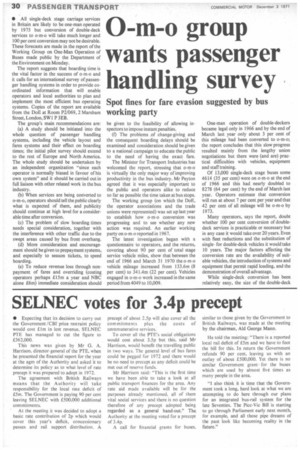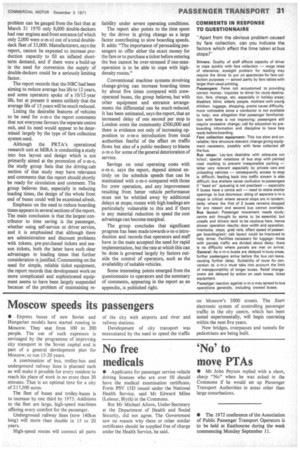SELNEC votes for 3.4p precept
Page 32

Page 33

If you've noticed an error in this article please click here to report it so we can fix it.
• Expecting that its decision to carry out the Government /C131 price restraint policy would cost Lim in lost revenue, SELNEC PTE has managed to cut the figure to £362,000.
This news was given by Mr G. A. Harrison, director-general of the PTE, when he presented the financial report for the year at the agm of the Authority and asked it to determine its policy as to what level of rate precept it was prepared to adopt in 1972.
The agreement with British Railways means that the Authority will take responsibility for the local rate deficit of £5m. The Government is paying 90 per cent leaving SELNEC with £500.000 additional corn mitments.
• At the meeting it was decided to adopt a basic rate contribution of 2p which would cover this year's deficit, concessionary passes and rail support distribution. A precept of about 2.5p will also cover all the commitments plus the costs of unremunerative services.
To cover all the PTE's social obligations would cost about 3.5p but this, said Mr Harrison, would benefit the travelling public in two ways. The general level of bus fares could be pegged for 1972 and there would be no need to precept as any deficit could be met out of reserve funds.
Mr Harrison said: "This is the first time we have been able to take a look at all public transport finances for the area. Any rate aid made available will be for the purposes already mentioned, all of them vital social services and there is no question therefore of any precept adopted being regarded as a general hand-out." The Authority at the meeting voted for a precept of 3.4p.
A call for financial grants for buses. similar to those given by the Government to British Railways, was made at the meeting by the chairman, Ald George Mann.
He told the meeting: "There is a reported local rail deficit of £5m and we have to foot the bill for this. In return the Government refunds 90 per cent, leaving us with an outlay of about £500,000. Yet there is no similar Government grantfor the buses which are used by almost five times as many people in the area.
"1 also think it is time that the Government took a long, hard look at what we are attempting to do here through our plans for an integrated bus-rail system for the late Seventies. The Picc-Vic Bill is starting to go through Parliament early next month, for example, and all those pipe dreams of the past look like becoming reality in the future." problem can be gauged from the fact that at March 31 1970 only 8,000 double-deckers had rear engines and front entrance (of which only 2,000 were o-m-o) out of a total doubledeck fleet of 33,000. Manufacturers, says the report, cannot be expected to increase production capacity to fill an inflated shortterm demand, and if there were a build-up in the need for conversion the supply of double-deckers could be a seriously limiting factor.
The report records that the NBC had been aiming to reduce average bus life to 12 years, and some operators spoke of a 10/12-year life, but at present it seems unlikely that the average life of 15 years will be much reduced.
Listing the desirable features of vehicles to be used for o-m-o the report comments that not everyone favours the separate centre exit, and its need would appear to be determined largely by the type of fare collection system used.
Although the PRTA's operational research unit at MIRA is conducting a study into bus layout and design which is not primarily aimed at the promotion of o-m-o, the study group feels that the driving-cab section of that study may have relevance and comments that the report should shortly be ready for circulation and comment. The group believes that, especially in reducing loading times, the design of the whole front end of buses could well be examined afresh.
Emphasis on the need to reduce boarding times appears in several sections of the report. The main conclusion is that the largest contributor to time saving is the passenger, whether using self-service or driver service, and it is emphasised that although there are administration and discount problems with tokens, pre-purchased tickets and season tickets, both the latter have such clear advantages in loading times that further consideration is justified. Commenting on the need for simple, reliable ticket equipment, the report records that development work on more complicated and sophisticated equipment seems to have been largely suspended because of the problem of maintaining re
liability under severe operating conditions.
The report also points to the time spent by the driver in giving change as a large factor contributing to slow boarding speeds. It adds: "The importance of persuading passengers to offer either the exact money for the fare or to purchase a ticket before entering the bus cannot be over-stressed if one-manoperation is to be able to cope with highdensity routes."
Conventional machine systems involving change-giving can increase boarding times by about five times compared with crewoperated buses, the group believes, but with other equipment and entrance arrangements the differential can be much reduced. It has been estimated, says the report, that an increased delay of one second per stop in London costs the community £500,000 and there is evidence not only of increasing opposition to o-m-o introduction from local. authorities fearful of the effect on traffic flows but also of a public tendency to blame o-m-o for some of the general deterioration of service.
Savings on total operating costs with o-m-o, says the report, depend almost entirely on the schedule speeds that can be maintained with o-m-o compared with those for crew operation, and any improvement resulting from better vehicle performance must not be whittled away by additional delays at stops; routes with high loadings are particularly vulnerable to this and if there is any material reduction in speed the cost advantage can become marginal.
The group concludes that significant progress has been made towards o-m-o introduction and records that operators and staff have in the main accepted the need for rapid implementation, but the rate at which this can be done is governed largely by factors outside the control of operators, such as the availability of suitable vehicles.
Some interesting points emerged from the questionnaire to operators and the summary of comments, appearing in the report as an appendix, is published right.


































































































































